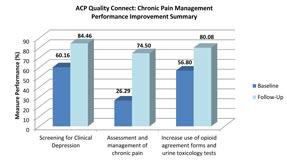Calculating risk for cholesterol drugs
Differing guidelines and a new class of drugs may cause uncertainty on the part of patients and practitioners.
Scarcely had the ink dried on a thicket of recent cholesterol guidance before the approval of a new class of drugs earlier this year threatened to rekindle and potentially inflame some differences in how doctors are advised to treat patients.
The lingering debate, which primarily involves heart disease prevention, stems from the publication of the American College of Cardiology/American Heart Association (ACC/AHA) guidelines in 2013, which were quickly followed by several more sets of guidance, including from the National Lipid Association and the U.S. Department of Veterans Affairs (VA) and Department of Defense (DoD).

The various guidelines and recommendations concur in several key areas, including the importance of emphasizing better diet and other nondrug lifestyle changes, the benefits of statins, and the need for frank risk-benefit discussions with patients. But they don't necessarily align regarding how to identify which patients should start statins and how to assess the drugs' effectiveness moving forward, said Seth Martin, MD, a cardiologist and associate director of the lipid clinic at Johns Hopkins University School of Medicine in Baltimore.
Dr. Martin coauthored a piece published in September in Mayo Clinic Proceedings that argued for more unified cholesterol management guidance. “Having these differing guidelines seems to be confusing and may lead to less confidence on the part of patients and practitioners and may even lead to non-action on the part of folks,” he said.
The recent approval of the first PCSK9 inhibitors, with their pricey but powerful lipid-lowering properties, might amplify this ongoing treatment dilemma. The 2 drugs, alirocumab (Praluent) and evolocumab (Repatha), were approved by the FDA for patients with familial hypercholesterolemia or those who have had a heart attack or stroke and can't get their LDL levels under control.
But some experts worry that the costly new drugs could be prescribed more widely, particularly given what they perceive as some murkiness in current cholesterol guidance. In a commentary published online Aug. 10 by the Journal of the American Medical Association (JAMA), several leaders from CVS Health, the health care company that operates CVS pharmacies and other drugstores, questioned the ACC/AHA guidelines' lack of focus on treating to specific cholesterol targets and wondered whether doing so should be reconsidered “to facilitate the cost-effective use” of PCSK9 inhibitors.
Neil Stone, MD, MACP, lead author on the 2013 ACC/AHA guidelines, stressed that lipid levels' importance has never been tabled, although that has sometimes been misinterpreted since the guidelines' release. Rather, he said, lipids should be monitored in the context of overall cardiovascular vulnerability, with a risk-benefit conversation recommended if 10-year risk of a heart attack or stroke exceeds 7.5% on the ACC/AHA calculator.
“We never said that 7.5% meant automatic statin assignment,” said Dr. Stone, Bonow Professor of Medicine (Cardiology) at Northwestern University Feinberg School of Medicine in Chicago. “We simply said that there was class 1 evidence for treatment and that a clinician-patient risk discussion should then ensue.”
Too risky or not?
To better capture that 10-year cardiovascular risk, the ACC/AHA calculator incorporates some key elements for the first time, such as the stroke vulnerability faced by women and African-Americans, Dr. Stone said. But the new calculator has been criticized in some quarters by researchers who argue that it overestimates who needs to take drugs. In 1 analysis of data from the Women's Health Study published in December 2014 in JAMA Internal Medicine, the ACC/AHA calculator predicted that 3.6% of the women would have a heart attack or stroke over the subsequent decade. In fact, 2.2% did.
But studies critiquing the ACC/AHA calculator, including the above, were based on adults involved in research trials who as a group might not reflect the general population, Dr. Stone said. The REGARDS trial, a natural history study published in JAMA in March 2014, showed that the ACC/AHA risk calculator predicted quite well, he noted. He cited another analysis, published on April 10, 2014, in the New England Journal of Medicine (NEJM), as illuminating the guidelines' cardiovascular potential.
The NEJM study found that applying the new ACC/AHA guidelines versus the prior version resulted in 12.8 million more Americans becoming eligible for statins, an 11% increase. Of those, 10.4 million would be taking the drugs for primary prevention. Most important, Dr. Stone said, the analysis projected that wider statin use for primary prevention would avert 475,000 cardiovascular events over a 10-year period. Further studies have shown that in those additional Americans taking statins, the number needed to treat (NNT) to prevent an event is low (less than 30), he noted.
In developing the guidelines, the committee also took into account the possibility of overestimation, Dr. Stone said. “We purposely chose 7.5% and not 5%, so if there was some overestimation, a person would still be in a risk-benefit category,” he said.
He also pointed out that 2 recent studies published in the July 14 JAMA supported the effectiveness and cost-effectiveness of the ACC/AHA guidelines and that an accompanying editorial called the risk calculator “a justifiable approach to risk assessment” and said that the 7.5% threshold was also justifiable and “may even be too conservative.”
The clinical practice guideline from the VA/DoD, though, adopted a higher threshold of 12% before recommending consideration of a statin, citing clinical trial outcome data and, in part, the tendency of existing calculators to overestimate risk. The joint guidance, published Aug. 18 in Annals of Internal Medicine, doesn't recommend any specific calculator.
And for those adults with an intermediate risk of 6% to 12%, the research body of evidence isn't as strong, particularly for the older and veteran population that the VA and DoD serve, said John R. Downs, MD, FACP, a coauthor on the Annals synopsis and a staff internist at the South Texas Veterans Health Care System in San Antonio. “That definitely needs a patient-centered discussion before offering any sort of treatment,” he said.
When speaking with the patient, doctors should also take the time to clarify the individual's baseline risk of a heart attack or stroke, rather than just percentage reductions, particularly if that risk is relatively low to begin with, Dr. Downs said. “Side effects increase more or less linearly with the dose,” he said, pointing to data regarding muscle-related effects of statins in some patients.
Meanwhile, the National Lipid Association's dyslipidemia recommendations, published in October 2014 by the Journal of Clinical Lipidology, don't settle on a single threshold, with figures varying based on the risk calculator used. For the ACC/AHA calculator, the association suggests recommending statins at a 10-year risk of 15% or higher.
But the association only recommends using a risk calculator in primary prevention situations where the patient is considered at moderate risk, with 2 major cardiovascular risk factors, and it's useful “as a tie breaker” regarding whether the patient is a good candidate for statins, said James Underberg, MD, FACP, clinical assistant professor of medicine at the New York University School of Medicine in New York City, as well as a member of the National Lipid Association's executive committee.
Statins: starting and monitoring
Even prior to the ACC/AHA guidelines, overprescribing of statins did occur, such as in the very elderly, said Michael Johansen, MD, an assistant professor of family medicine at Wexner Medical Center at Ohio State University in Columbus. He coauthored an analysis, published online Aug. 24 by JAMA Internal Medicine, looking at statin prescribing in 13,099 adults age 80 and older from 1999 through 2012. One-third of those without heart disease reported taking a statin despite a lack of clear guidance regarding its role in that age group in the Adult Treatment Panel III guidelines, he said.
Dr. Johansen said that his approach is to generally wait until that risk is closer to 15% on the ACC/AHA calculator before initiating a risk-benefit statin conversation. Still, other factors can be influential, such as family history in a patient whose parent had a heart attack in their 30s. Dr. Johansen said. “Their risk might be 7.5%, and it might be very reasonable for this person to be on a statin.”
Dr. Johansen also doesn't regularly check lipid levels once the patient begins a statin, another area where guidance from medical groups differs. (He noted some exceptions, such as if patients have familial hypercholesterolemia or if he's concerned that they're not reliably taking the drugs.) Nor do the VA/DoD clinical practice guidelines recommend routine monitoring, once lipids are checked as part of a risk assessment profile to determine whether to prescribe statins.
Once a patient starts taking a statin, its effect should be based on the target dose and not routinely checking the lipid levels, the VA/DoD authors wrote.
Both the VA/DoD and the ACC/AHA authors cite the lack of randomized trials in primary prevention to demonstrate the benefit of adjusting the statin regimen to achieve an LDL target. But the ACC/AHA guidelines never said to forgo ongoing lipid monitoring entirely, Dr. Stone said. Instead, they outline a regimen of testing, starting with a second panel within the first 12 weeks after the drug is started to check adherence and then every 3 to 12 months afterward as clinically needed.
While no specific LDL number is recommended, it's important to monitor whether the drug had achieved a specific LDL reduction, from 30% to 50% in the case of a moderate-intensity statin, Dr. Stone said.
Meanwhile, the National Lipid Association in its 2014 recommendations doubled down on the need for targets, specifying that both LDL and non-HDL should be tracked, with the latter of particular importance. Although the authors acknowledged that randomized studies haven't been conducted that demonstrate better heart attack and stroke results with targets, they said a broader pool of data including observational results indicate a lower-is-better LDL payoff for patients.
Moreover, treatment complications can arise if a patient's lipid panels aren't being periodically checked, said Dr. Underberg, a co-author of a peer-reviewed overview of the differences and similarities of the guidelines and recommendations. For example, he noted, what if a new patient comes into a doctor's office on a statin? How does that new doctor know if the patient has already achieved a 50% reduction?
“You need a metric,” he said. “People [patients, doctors, and insurers] need to understand where they are and how to get there on all sides of the equation.”
Stage left: the PCSK9 inhibitors
The CVS opinion piece published in JAMA also supported lipid targets, citing other groups besides the National Lipid Association that agree, including the American Association of Clinical Endocrinologists. “As clinicians and payers prepare for the entry of PCSK9 inhibitors to the market, there is a need to achieve consensus around management strategies for patients with hyperlipidemia,” the CVS leaders wrote, noting that alirocumab is priced at $14,600 annually.
Another analysis published in September also turned the spotlight on cost. For the new drugs to be priced to reflect their clinical value without unduly straining the health system, the annual cost would have to be reduced to $2,177, said a draft report by the Institute for Clinical and Economic Review, a nonprofit research organization.
Doctors will have to wait for results from ongoing trials, including FOURIER (Further Cardiovascular Outcomes Research With PCSK9 Inhibition in Subjects With Elevated Risk), to learn whether the drugs not only dramatically reduce LDL levels but also reduce heart attacks and stroke over the long term, said Dr. Martin, the Johns Hopkins cardiologist. But he described the shorter-term results of a recent meta-analysis, published on July 7 in Annals of Internal Medicine, as encouraging.
That analysis, which used data from 2 dozen phase 2 and phase 3 studies, found no serious adverse effects. It also found that PCSK9 inhibitors reduced heart attack and all-cause mortality, plus led to a nonsignificant reduction in cardiovascular mortality.
Dr. Martin, who coauthored the accompanying editorial, noted that the clinical study data cover only a short period, relevant as some patients could take these drugs for decades, and that the included studies weren't designed to assess cardiovascular outcomes, including deaths. “As a function of that, each individual study [in the meta-analysis] has a relatively small number of outcomes,” he said.
There are also some outstanding questions regarding the long-term impact of pushing LDL to such low levels, Dr. Martin said. “We don't have a ton of long-term data on if people tolerate these very low levels well over time, or whether adverse effects pop up because of these very low LDL levels,” he said.
In the near term, Dr. Martin said that use of PCSK9 inhibitors for primary prevention will likely be limited to those individuals with familial hypercholesterolemia, which he notes is an undertreated group to begin with. (At least 90% of people are undiagnosed, according to the Familial Hypercholesterolemia Foundation.) The insurers are clearly watching this class of drugs closely, Dr. Underberg said. As of early fall, he'd had a couple of insurer denials, including for a patient with familial hypercholesterolemia. “They are setting the bar pretty high,” he said.





